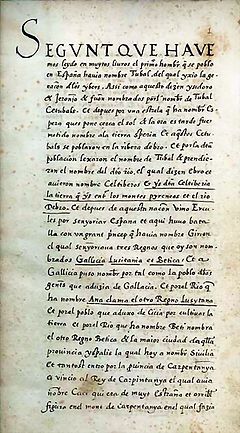- Chronicle of San Juan de la Peña
-
 Crónica de San Juan de la Peña (fol. 1r).
Crónica de San Juan de la Peña (fol. 1r).
The Chronicle of San Juan de la Peña (Aragonese: San Chuan d'a Peña) is an Aragonese chronicle written in Latin around 1370 in the monastery of San Juan de la Peña at the behest of Peter IV of Aragon. It was the first general history of Aragon and was probably designed both to justify the royal prerogatives of the Crown of Aragon against the baronage and to match the comparable Castilian work of a century earlier, the Estoria de España.
The Chronicle is a compilation from various sources, some more historically solid than others. Though named after the monastery of San Juan, it was only partially compiled there. As early as 1345 Peter IV had asked the monasteries of San Juan and Ripoll to begin compiling material for a general history of the realm. Ripoll's only contribution was a version of the 1162 Gesta comitum Barchinonensium updated to 1310. Only those sections (approximate a third) dealing with events specific to the monastery were probably written in it. The monks of San Juan relied heavily for the history of Spain up to 1137 on De rebus Hispaniae, the work of the Navarrese Rodrigo Jiménez de Rada. The materials compiled at Ripoll and San Juan were eventually sent to Barcelona to be worked together. A finished copy of the work was sent by the king to the Cathedral of Valencia in 1372 and this original still resides in the cathedral library.
A modern Spanish translation by Antonio Ubieto Arteta appeared in 1964, an English translation by Lynn H. Nelson in 1991.
References
- Arteta, Antonio Ubieto. Crónica de San Juan de la Peña. Textos medievales, 4. Valencia: Anubar, 1964.
- Constable, Olivie Remie, ed. "Concerning King Sancho I of Aragon and His Deeds" trans. Lynn H. Nelson. Medieval Iberia: Readings from Christian, Muslim, and Jewish Sources. Pittsburg: University of Pennsylvania Press, 1997. ISBN 0 812 215 699.
- Nagore Laín, Francho, El aragonés del siglo XIV según el texto de la Crónica de San Juan de la Peña, Instituto de Estudios Altoaragoneses, 2003. ISBN 84-8127-134-9.
- Nelson, Lynn Harry, trans. The Chronicle of San Juan de la Peña: A Fourteenth-Century Official History of the Crown of Aragon. Pittsburg: University of Pennsylvania Press, 1991. ISBN 0 812 213 521.
Categories:- 1370
- 14th-century history books
- Iberian chronicles
Wikimedia Foundation. 2010.
